¿Quieres añadir paginación numérica en tu tema de WordPress?
Por defecto, los temas de WordPress añaden un enlace Siguiente / Anterior en la parte inferior de las páginas de archivo. El problema es que no son muy fáciles de usar. Por eso, muchos blogs populares utilizan la paginación numérica para facilitar a los visitantes la navegación por sus páginas de archivo.
En este artículo, le mostraremos cómo añadir paginación numérica en su tema de WordPress.
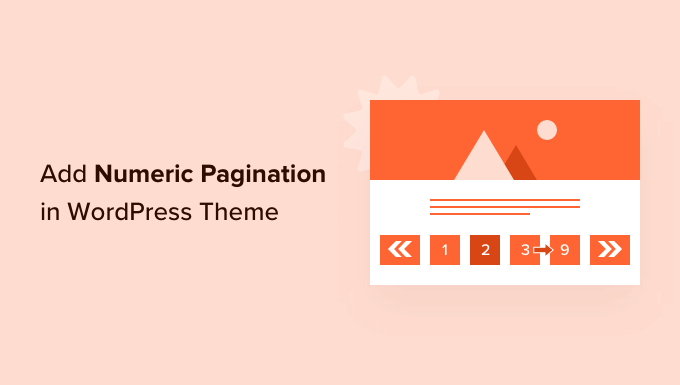
¿Por qué añadir paginación numérica en su tema de WordPress?
La mayoría de los temas tienen una página de archivo que muestra una lista de entradas. A medida que publiques más entradas en tu blog de WordPress, tu página de archivo abarcará varias páginas.
Los enlaces de paginación ayudan a los visitantes a moverse entre las páginas del archivo y suelen aparecer en la parte inferior de su sitio web WordPress.
Algunos temas de WordPress enlazan las entradas más antiguas con las más recientes. Sin embargo, esto solo permite al visitante avanzar y retroceder una página.
Tampoco muestra la ubicación actual del visitante en el archivo. Esto puede dificultar la navegación de los visitantes por el archivo de su blog.
Ahí es donde entra en juego la paginación numérica.
En lugar de mostrar enlaces “Más antiguo” y “Más reciente”, la paginación numérica muestra una serie de números que permiten a los visitantes saltar a una página concreta del archivo.
La paginación numérica también puede utilizar resaltes o colores diferentes para mostrar el número de página actual, de modo que el visitante siempre sepa exactamente en qué parte del archivo se encuentra.
En WPBeginner, utilizamos la paginación numérica y resaltamos en naranja el número de la página actual. También enlazamos directamente las 4 páginas que rodean a la página actual del visitante.
Incluso tenemos un enlace a la última página de nuestro archivo, para que los visitantes puedan ver rápida y fácilmente nuestras entradas más antiguas, como puede verse en la siguiente imagen.
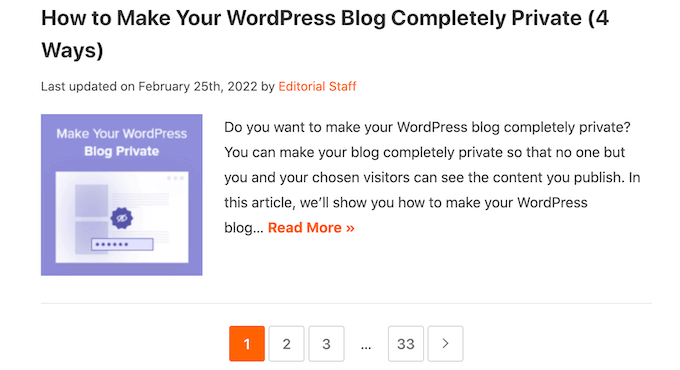
En nuestra experiencia, este tipo de paginación numérica hace que su sitio sea más fácil de navegar en comparación con los enlaces por defecto ‘Entradas más antiguas’ y ‘Entradas más recientes’.
Si su tema de WordPress tiene paginación ‘Older’ y ‘Newer’, siempre recomendamos sustituirla por paginación numérica.
En esta guía, vamos a cubrir dos maneras diferentes de añadir paginación numérica en su tema de WordPress. Si prefiere saltar directamente a un método en particular, entonces usted puede utilizar los siguientes enlaces.
- Método 1. Cómo añadir paginación numérica en WordPress usando WP-PageNavi
- Método 2. Cómo añadir manualmente paginación numérica en su tema de WordPress
Método 1. Cómo añadir paginación numérica en WordPress usando WP-PageNavi
La forma más sencilla de añadir paginación numérica en WordPress es utilizando el plugin WP-PageNavi.
Para usar este plugin, aún necesitarás hacer algunos cambios en el código de tu tema, pero es mucho más fácil que el método del código completo porque WP-PageNavi te da control completo sobre la paginación de tu sitio.
Lo primero que tienes que hacer es instalar y activar el plugin WP-PageNavi. Para más detalles, consulta nuestra guía paso a paso sobre cómo instalar un plugin de WordPress.
Después de activar el plugin vaya a Ajustes ” PageNavi para establecer los ajustes del plugin.
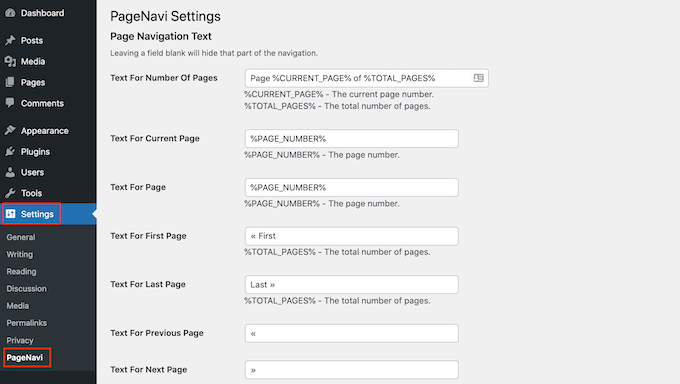
Aquí puede sustituir cualquier texto de paginación por defecto por su propio texto. Por ejemplo, puede cambiar el texto que su sitio web utiliza para enlazar “Primera página” y “Última página”.
También puede personalizar los enlaces de paginación numérica.
En la sección “Número de páginas a mostrar”, puede elegir cuántas páginas mostrará el plugin en la sección de paginación de su sitio web.
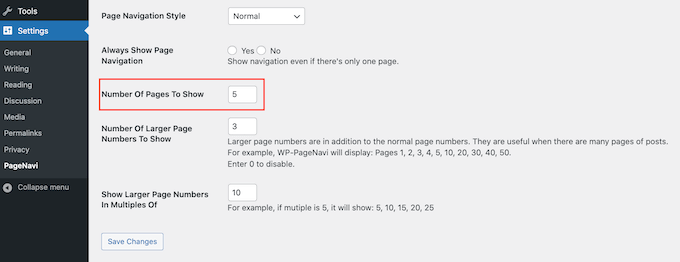
Esto se establece en 5 por defecto, lo que significa WP-PageNavi mostrará enlaces directos a 5 páginas.
Como puede ver en la siguiente captura de pantalla, si está en la página 4, verá enlaces a las páginas 2, 3, 4, 5 y 6.
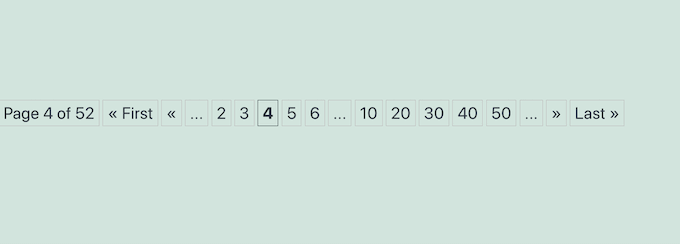
Puede que desee mostrar más o menos páginas. Para hacer este cambio, simplemente escriba el nuevo número en el campo ‘Número de páginas a mostrar’.
Por defecto, el plugin mostrará varios números más grandes. Esto permite a los visitantes avanzar por varias páginas, con un solo clic.
Por defecto, el plugin muestra tres números más grandes que aumentan de 10 en 10 cada vez. Por ejemplo, 10, 20 y 30.
¿Desea utilizar un intervalo diferente, como 5 o 20? Escriba el nuevo intervalo en el campo “Mostrar números de página más grandes en múltiplos de”.

Cada sitio de WordPress es diferente, por lo que es una buena idea probar diferentes ajustes para ver qué ajustes de paginación funcionan mejor para usted.
Si ha realizado algún cambio en los ajustes de WP-PageNavi, no olvide desplazarse hasta el final de la página y hacer clic en el botón Guardar cambios.
A continuación, debes añadir una etiqueta de plantilla en tu tema de WordPress. Para ello, te recomendamos que crees un tema hijo y edites su código.
Al crear un tema hijo, puedes seguir actualizando tu tema de WordPress de forma segura sin perder tu paginación numérica personalizada. Para obtener más información, consulta nuestra guía paso a paso sobre cómo crear un tema hijo de WordPress.
No importa si eliges editar un tema padre o hijo, necesitarás un cliente FTP. Si es la primera vez que utilizas FTP, puedes consultar nuestra guía completa sobre cómo conectarte a tu sitio utilizando FTP.
Cuando esté conectado a su cuenta de alojamiento de WordPress a través de FTP, estará listo para editar el código de su tema de WordPress.
Estos pasos variarán en función del tema de WordPress. Sin embargo, normalmente tendrás que editar el código de tu archivo index.php o archive.php, además de cualquier otro archivo de plantilla de tu tema de WordPress.
Basta con abrir estos archivos y buscar las etiquetas previous_posts_link y next_posts_link.
Si encuentra estas etiquetas, sustitúyalas por el siguiente fragmento de código:
1 | <?php wp_pagenavi(); ?> |
Algunos temas pueden no tener las etiquetas previous_posts_link o next_posts_link.
Si no encuentras estas etiquetas en tu tema, busca en su lugar the_posts_navigation. Por ejemplo, encontrarás lo siguiente en el archivo archive.php del tema Twenty Twenty-One:
1 | <?php /*twenty_twenty_one_the_posts_navigation();*/ |
A continuación, puede sustituir esta línea por el siguiente fragmento de código:
1 | <?php wp_pagenavi(); ?> |
Tras realizar estos cambios, guarde o cierre los archivos de temas de WordPress que tenga abiertos.
Ahora, si usted visita su página de archivo de WordPress debería ver su nueva paginación numérica en vivo en su sitio web.
En este punto es posible que desee cambiar el color y el estilo de la paginación numérica, por lo que mejor se complementa con su tema o la imagen de marca del sitio web.
Puede hacerlo editando el código del plugin.
Sin embargo, recomendamos pegar el código de WP-PageNavi en el archivo style.css de su tema, y luego hacer sus cambios dentro del archivo del tema. Esto significa que no perderás tus personalizaciones cuando actualices el plugin WP-PageNavi.
Para copiar el código de tu plugin, dirígete a Ajustes ” PageNavi. A continuación, busque la sección “Usar pagenavi-css.css” y haga clic en el botón de opción “No” situado a su lado.
No olvides hacer clic en el botón “Guardar cambios” para guardar las modificaciones.
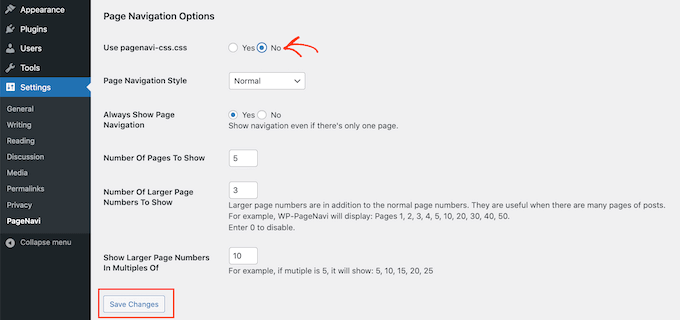
A continuación, vaya a Plugins ” Editor de archivos de plugins.
A continuación, abra el menú desplegable “Seleccionar plugin para editar” y elija “WP-Page Navi”. Después de eso, usted está listo para hacer clic en ‘Seleccionar’.

En el menú de la derecha, haga clic en el archivo pagenavi-css.css.
A continuación, siga adelante y copie todo el código en este archivo.
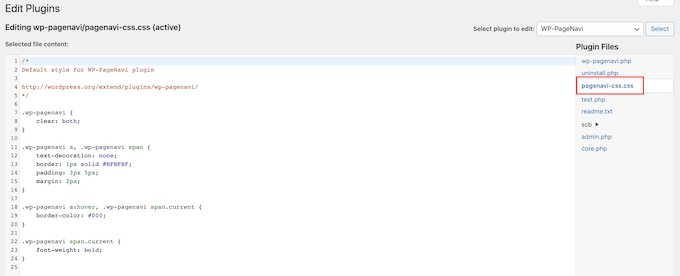
A continuación, vaya a Apariencia ” Editor de archivos de temas.
En el menú de la derecha, haga clic en el archivo style.css de su tema.
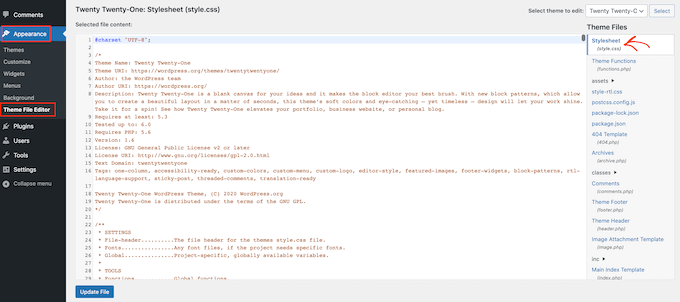
Ahora puede pegar el código pagenavi-css.css en el archivo style.css del tema y empezar a realizar los cambios.
Veamos un ejemplo. Aquí tienes una versión modificada del código de paginación numérica que puedes añadir al archivo style.css de tu tema:
1 2 3 4 5 6 7 8 9 10 11 12 13 14 15 16 17 18 19 20 21 22 | wp-pagenavi { clear: both;} .wp-pagenavi a, .wp-pagenavi span { color: #FFF; text-decoration: none; background-color:#6FB7E9; border: 1px solid #B2D1E5; padding: 5px 5px; margin: 2px;} .wp-pagenavi a:hover, .wp-pagenavi span.current { border-color: #E9F2F9; background-color:#6FB7E9;} .wp-pagenavi span.current { font-weight: bold; background-color:#3C8DC5;} |
En la siguiente imagen, puede ver cómo se verá esta paginación numérica en su sitio.
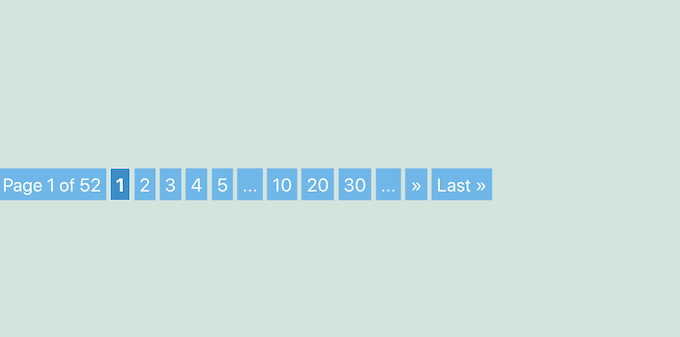
Vale la pena probar diferentes estilos para ver cuál queda mejor en su sitio web de WordPress.
Cuando esté satisfecho con el aspecto de su paginación numérica, haga clic en el botón Actualizar archivo para guardar los cambios.
Método 2. Cómo añadir manualmente la paginación numérica en su tema de WordPress
Otra opción es añadir manualmente la paginación numérica en su tema de WordPress utilizando código.
Muchos temas de WordPress vienen con enlaces ‘Older’ y ‘Newer’, o paginación numérica por defecto. Por ejemplo, el popular tema Astra añade automáticamente su propia paginación numérica a tus páginas de archivo, como puedes ver en la siguiente imagen.
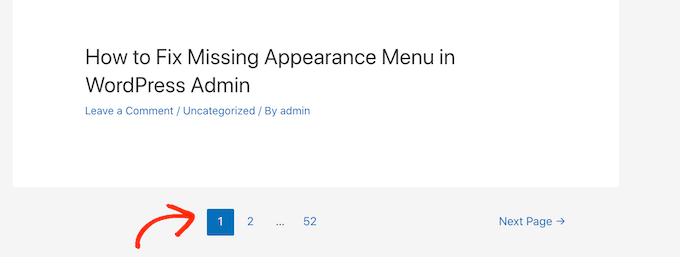
Puede utilizar este método para personalizar la paginación integrada de un tema. Por ejemplo, puede cambiar el estilo para que se adapte mejor a su sitio.
Para añadir manualmente la paginación numérica, abra el archivo functions.php de su tema. Aquí puedes usar un cliente FTP o el gestor de archivos del cPanel de tu alojamiento WordPress. Si estás usando FTP, entonces puedes ver nuestra guía completa sobre cómo conectarte a tu sitio usando FTP.
Una vez que se haya conectado correctamente a su sitio, abra el archivo functions.php y añada el siguiente código:
1 2 3 4 5 6 7 8 9 10 11 12 13 14 15 16 17 18 19 20 21 22 23 24 25 26 27 28 29 30 31 32 33 34 35 36 37 38 39 40 41 42 43 44 45 46 47 48 49 50 51 52 53 54 55 56 57 58 59 60 61 62 63 64 65 66 67 68 | function wpbeginner_numeric_posts_nav() { if( is_singular() ) return; global $wp_query; /** Stop execution if there's only 1 page */ if( $wp_query->max_num_pages <= 1 ) return; $paged = get_query_var( 'paged' ) ? absint( get_query_var( 'paged' ) ) : 1; $max = intval( $wp_query->max_num_pages ); /** Add current page to the array */ if ( $paged >= 1 ) $links[] = $paged; /** Add the pages around the current page to the array */ if ( $paged >= 3 ) { $links[] = $paged - 1; $links[] = $paged - 2; } if ( ( $paged + 2 ) <= $max ) { $links[] = $paged + 2; $links[] = $paged + 1; } echo '<div class="navigation"><ul>' . "\n"; /** Previous Post Link */ if ( get_previous_posts_link() ) printf( '<li>%s</li>' . "\n", get_previous_posts_link() ); /** Link to first page, plus ellipses if necessary */ if ( ! in_array( 1, $links ) ) { $class = 1 == $paged ? ' class="active"' : ''; printf( '<li%s><a href="%s">%s</a></li>' . "\n", $class, esc_url( get_pagenum_link( 1 ) ), '1' ); if ( ! in_array( 2, $links ) ) echo '<li>…</li>'; } /** Link to current page, plus 2 pages in either direction if necessary */ sort( $links ); foreach ( (array) $links as $link ) { $class = $paged == $link ? ' class="active"' : ''; printf( '<li%s><a href="%s">%s</a></li>' . "\n", $class, esc_url( get_pagenum_link( $link ) ), $link ); } /** Link to last page, plus ellipses if necessary */ if ( ! in_array( $max, $links ) ) { if ( ! in_array( $max - 1, $links ) ) echo '<li>…</li>' . "\n"; $class = $paged == $max ? ' class="active"' : ''; printf( '<li%s><a href="%s">%s</a></li>' . "\n", $class, esc_url( get_pagenum_link( $max ) ), $max ); } /** Next Post Link */ if ( get_next_posts_link() ) printf( '<li>%s</li>' . "\n", get_next_posts_link() ); echo '</ul></div>' . "\n"; } |
Este código obtiene el número de páginas, listo para que lo muestres en tu tema de WordPress.
Los siguientes pasos variarán en función de su tema.
Si tu tema no tiene alguna forma de paginación por defecto incorporada, entonces puedes simplemente añadir la siguiente etiqueta de plantilla en tu index.php, archive.php, category.php, o cualquier otra página donde quieras mostrar paginación numérica.
1 | <?php wpbeginner_numeric_posts_nav(); ?> |
Tenga en cuenta que el lugar en el que añada este código afectará al lugar en el que se mostrará la paginación numérica en su sitio web.
Normalmente, querrá mostrar la paginación en la parte inferior de sus páginas de archivo, por lo que normalmente querrá añadir la etiqueta de plantilla a su código de pie de página.
¿Tu tema ya tiene alguna forma de paginación, como enlaces a “Entradas más antiguas” y “Entradas más recientes”?
En este caso, tendrá que encontrar el código de paginación y sustituirlo por el fragmento de código anterior.
Por ejemplo, Ashe es uno de los mejores temas gratuitos para blogs de WordPress y ya añade los enlaces de paginación “Primera” y “Última página” a sus páginas de archivo.
Para sustituir estos enlaces integrados por la paginación numérica, debe editar los archivos templates/grid.php y templates/blog-pagination.php del tema.
En cada uno de estos archivos, basta con encontrar la siguiente sección:
1 | <?php get_template_part( 'templates/grid/blog', 'pagination' ); ?> |
A continuación, puede sustituir esta línea por el siguiente fragmento de código:
1 | <?php wpbeginner_numeric_posts_nav(); ?> |
Una vez añadido el código, no olvides guardar los cambios.
El siguiente paso es personalizar la paginación numérica.
Para ayudar a los visitantes a navegar por el archivo, vamos a resaltar el número de la página actual con un color diferente. Para ello, abra el archivo style.css de su tema y, a continuación, pegue el siguiente código en este archivo:
1 2 3 4 5 6 7 8 9 10 11 12 13 14 15 16 17 18 19 20 21 22 23 24 25 26 27 | .navigation li a,.navigation li a:hover,.navigation li.active a,.navigation li.disabled { color: #fff; text-decoration:none;} .navigation li { display: inline;} .navigation li a,.navigation li a:hover,.navigation li.active a,.navigation li.disabled { background-color: #6FB7E9; border-radius: 3px; cursor: pointer; padding: 12px; padding: 0.75rem;} .navigation li a:hover,.navigation li.active a { background-color: #3C8DC5;} |
Después, sólo tiene que guardar los cambios haciendo clic en el botón Actualizar archivo.
Ahora, si visita la página del archivo, verá la paginación numérica en su sitio web.
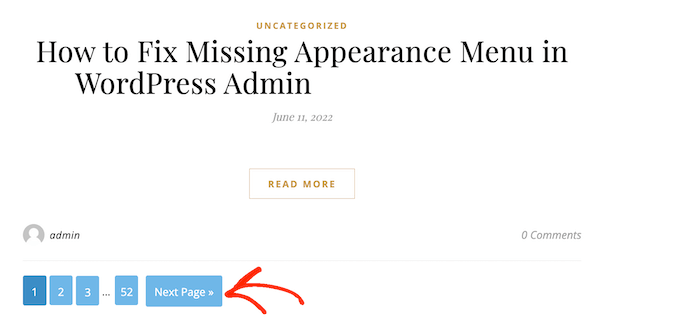
Esperamos que este artículo te haya ayudado a aprender cómo añadir paginación numérica en tu tema de WordPress. También puede consultar nuestra guía sobre cómo ganar dinero en línea blogueando con WordPress y cómo crear un tema de WordPress personalizado sin escribir ningún código.
If you liked this article, then please subscribe to our YouTube Channel for WordPress video tutorials. You can also find us on Twitter and Facebook.




Tom
You really helpped me. Thanks !
Sam
Thanks very helpful
lucky cabarlo
how can i adjust the numbers to show in the custom numeric pagination
spongie
how do you limit the page number to say up to 2 only then show ellipsis?
krishma
can i use this plugin for custom post type
Astra
Of course mate. You just need to put this code into your page-custom.php
Med
Hello,
I found this very useful and I placed it to my new site. The problem is that it works perfect on the first page of the category, and after clicking on the “Next” link the url changes to /page/2/ but the highlighted page number is aways “1” and the content is always the first 10 articles (always in the first page).
I think there is something missing in my query:
<a href="”>
‘aligncenter’));
} else {
echo ”;
}
?>
Preeti Bhandari
how can i prevent whole page reload when clicking on next link, only want to refresh that particular section… Please help….
Luis Eduardo Braschi
Because “the goal is to replace the default Older and Newer pagination links at the bottom of archive pages” – and this is what “your” function does – “with easy to navigate page numbers.”.
Tony
Hi how do you get just the next and previous links only. thanks.
Barry
How can i use the wpbeginner_numeric_posts_nav(); for my Custom Post type?
I have replaced global $wp_query for
$args = array(
‘post_type’ => ‘my-cpt’,
‘meta_key’=>’cpt_detail’,
‘orderby’=>’meta_value’,
‘order’ => ‘ASC’,
‘paged’ => $paged
);
$cpt_query = new WP_Query($args);
and replaced $wp_query reference with $cpt_query but it doesn’t work
igloobob
Hi, did you ever figure this out please? I’m trying to get this working myself and struggling. Would appreciate your help very much if you got it working…
Ashley Michèlle
Using the ‘wpbeginner_numeric_posts_nav’ method, how would one change the navigation brackets? I’m not a huge fan of the ‘»’.
Thanks!
James George Dunn
Hello Ashley,
You can set a value in the brackets of get_previous_posts_link() and get_next_posts_link(). For example, get_next_posts_link(‘Next Post’) will show “Next Post” instead of the default “Next Page »”.
AmirMasoud
how can i change “Next Page” & “Previous page” text?
TimParkerRD
If you’re using the wpbeginner_numeric_posts_nav function, you can pass custom text to the get_next_posts_links() and get_previous_posts_link(), like so:
get_previous_posts_link(“Go Back”);
Daniel Ortiz
since Genesis Framework is not an open-source framework, are we allowed to use this code, commercially or not?( and are you allowed to distribute it?)
mr anon
thanks a lot
gosukiwi
Awesome, it works like a charm, I did some changes to fix my code though but the code is nice and well organized
Agarwalls
Thanks, Very helpful for me.
SJ
echo paginate_links( $args );
Why this one doesn’t do the job? I’m just curious
SJ
Why this one doesn’t do the job? I’m just curious
Baba agba
I tried it and its not working for me. Can you paste a simple example of your “paginated posts” code here
Nick
Has anyone had any luck getting this working with a custom WP_Query? It works perfect with the standard loop, but does not show up with a custom query. Any help would be great.
Thanks.
Marx
Have you tried the custom query examples noted from the codex?
http://codex.wordpress.org/Function_Reference/paginate_links
Hope that helps.
SJ
Well this one doesn’t work for me Don’t know why
Don’t know why
Mufaddal
Thanks so much, I tried your solution it worked for me.
Timberland
You have 2 options to do that, First is to use query_posts instead of Wp_Query
or the Second is to name your custom query “wp_query” as $wp_query = new WP_Query( $args );
important part in both approaches is to pass the ‘paged’ => $paged argument in your query otherwise won’t work,
//////////////////////////////////////With Wp_Query
$args = array( ‘cat’ => 3, ‘paged’ => $paged );
$wp_query = new WP_Query( $args );
if ( $wp_query->have_posts() ) :
while ( $wp_query->have_posts() ) {
$wp_query->the_post();
get_template_part( ‘content’, get_post_format() ); }
else :
echo “No post to show”;
endif;
wpbeginner_numeric_posts_nav();
wp_reset_postdata(); }
//////////////////////////////////////With Query_Posts
$args = array( ‘cat’ => 3, ‘paged’ => $paged );
query_posts( $args );
if ( have_posts() ) :
while ( have_posts() ) {
the_post();
get_template_part( ‘content’, get_post_format() ); }
else :
echo “No post to show”;
endif;
wpbeginner_numeric_posts_nav();
wp_reset_query(); }
[Hope that helps]
DavidCWebs
Try this native WP function: http://codex.wordpress.org/Function_Reference/paginate_links There’s an example on that codex page showing how to use it with WP_Query.
Hope this helps
Tim
Do this pagination have page number limits or does it automatically detect when more pages are required? Works really nicely
Akash Funde
Thanks for sharing this it helps a lot
Thanks you so Much
adrian
I’ve been using this successful for search results, archives, categories.. but it’s not working for tags. I suspect it could be a permalink issue. The first page works fine, but subsequent pages return 404s. Should this work for tags by default.?
Bubu
search results, archives are ok but in categories same error here. the first page is ok, second page return with 404.
need some help to solve this issue thx
Caroline
Thanks for this, it came in real handy making pagination Foundation framework-ready.
Hiro
I added this to my site and it shows up properly but doesn’t display the proper content on page 2. Tried it both manually and with the plugin. Both times, the pagnation links appear, and when i click to go to page 2, the url changes to page 2 but the content on the page shows only content from page 1 (or index). Please advise
Steve
I am new to Genesis but you say if we are using it that the function is already in there but when I tried adding the php to the hooked area, nothing would display so… I added the above code to my genesis functions.php and added the php call to my hooked area and now the pagination displays but it does not work. When I click the 2nd page, it just reloads the current page.
WPBeginner Support
please contact genesis support
Admin
Tyler
Does this work for wordpress.com sites? I have this blog that is set up via wordpress.com, not the installed version and I need to add pagination for the blog. Is there a way to do that? Thanks for any future help!
WPBeginner Support
No this tutorial is mean for Self hosted WordPress.org sites. As a WordPress.com user you can not directly edit themes.
Admin
Crear Cuenta Outlook
thank you so much
Rajavenkateshwaran
Am facing issues when i use the function within the custom page template. I created a custom page template to loop 4 of the posts, this function works well in Homepage and it doesnshow any sign of navigation links in page template.
Best Regards,
Raja
WPBeginner Support
If you are using a custom WP_Query then please check pagination parameters.
Admin
aklavya
thanx ……………… this code is very helpful
Dejan
Thank you for this code of pagination it is working with WP 3.7.1
Eli Overbey
Any thoughts on how to get archived pagination on Category Blog Page? (in Genesis)
I was able to create a page entitled ‘counseling-blog’, so now we have a Category Blog page at
But here’s the problem… No pagination. The /blog/ has the pagination from Genesis WP. All we have on that new Category Page page is:
”
There is no rel=”next” or rel=”prev”… Any thoughts on how to add next and prev to the Category Blog Page?
I thought the page would add those tags because the template is set as blog.
Big V
Nice post, but I’m having issues with /page/2 not working in my custom theme. Any advice?
Jeremy
WordPress has a core function for doing this.
http://codex.wordpress.org/Function_Reference/paginate_links
Gohar ul Islam
I am searching code (or any kind of help) which uses paginate_links in Wp_query. Do u have any code like this?
Dmitry
Thanks!
Mzer Michael Terungwa
I tried to implement this pagination on the single.php page but it did not show up. Is this only for theme’s index.php, archive.php, category.php, and any other archive page template?
Michael
It appears that Multiple Posts Pagination is quite different from single post pagination and would require different template tags to create them.
WPBeginner Support
Yes this code is only for index and archive pages.
Admin
Felipe Gangrel
Awesome. Thanks a lot!!!
Talha
Great code, thanks bro
Shaghayeggh
Thank you very very much
Marko
Hi,
thanks for great tutorial!
I had to add ul in front of every li in style.css, otherwise this worked perfectly.
(.navigation ul li a,) etc…
elvinson
i have installed wp-pagenavi plugin, but it was not showing in archives , so i have used your coding manually it is working well. Thanks.
Don
what about pagination for a single post that contains numerous pages .. i.e.- this is about A SINGLE POST – that was too long and had to be divided into multiple pages ! … the wp codex for this type of single post pagination is done with the command ( ) … unfortunately none of the plugins out there provides a good solution for this type of pagination ….. or they simple avoid it all together … the wp-pagenavi mentionned it very briefly…. but does not work for single post pagination on 95 % of the wp themes out there….
if there is such a plugin that provides a good alternative for wp_link_pages with good styling and other options for single post pagination …. please share !!!
Editorial Staff
Genesis theme has that option. We are using that on our site http://list25.com/
Admin
Chinmoy Paul
Thanks for sharing this. I will use this in my next project.
Robert Smith
Thanks for this guys! Been looking for a simple solution like this all evening and this was gold!!
Keep up the great work on your site, as it is a regular resource of mine
Thanks,
Rob
Arilton Freitas
To me, the best way to include numeric pagination in WordPress is use the paginate_links() function. Simple and core-based.
http://codex.wordpress.org/Function_Reference/paginate_links
Editorial Staff
Didn’t even know that existed. Thanks for pointing this out.
-Syed
Admin
Mattia
Indeed this is awesome, but… The pagination always appear, also if not needed… Ho do you prevent this?
If mu limit is 10 posts per page, but I only have written 5, the paginations appears and sends me to an empty “page 2″… ;(
Mattia
I checked another of my sites and this error doesn’t appear. In this late site I am building, strangely pagination appears also if not needed! Does someone know which could be the cause? Many thanks!
Jacob
WordPress already has this baked in with a function called paginate_links (http://codex.wordpress.org/Function_Reference/paginate_links).
Upendra Shrestha
Hi, Previously I used wp pagenavi plugin in genesis framework. But it didn’t work with the framework. After adding the code “”, it just worked. I didn’t realize that I had to add this code.
Thanks.
Alex Sancho
and what about the WordPress function paginate_links? http://codex.wordpress.org/Function_Reference/paginate_links
Connie
for those who want to style differently but are not CSS-savy, there are at least 2 additional plugins available:
WP Visual Pagination, http://wordpress.org/extend/plugins/wp-visualpagination/
or
WP PageNavi Style , http://wordpress.org/extend/plugins/wp-pagenavi-style/
Cheers,
Connie
Editorial Staff
Thanks for letting us know Connie.
Admin
Azim
Isn’t it going to be a heavy SQL query, esp. on blogs with lots and lots of posts? I had to get rid of such pagination on one of my projects (containing over 10K posts), because hoster claimed it consumed too much of a CPU and SQL resources. Basically, what it did is selected ALL posts (over 10K, remember?) and then just divided them into multiple pages with 20 (or whatever you specify in admin) posts per page…
Editorial Staff
WordPress is dividing the posts in those pages to begin with using the WP_Query posts_per_page parameter. All this query is doing is looking at those pages and creating a numeric display. I’m sure there was more going on that your host didn’t bother explaining.
-Syed
Admin